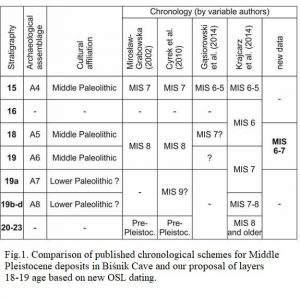New data on chronology of the early Middle Palaeolithic from Biśnik Cave, Poland
Maciej T. Krajcarz¹, Magdalena Sudoł-Procyk², Krzysztof Cyrek², Piotr Moska³ & Andrzej
Wiśniewski⁴
The chronological framework of the Middle Palaeolithic origins in central Europe is poorly
recognized relative to, for example, western European regions (Moncel et al., 2020). The main
reason for this is the sparsity of direct dating of sediments with artefacts and of the study of site
formation processes (Kozłowski, 2016; Wiśniewski, 2014). The scarcity of these data restricts
both the determination of settlement dynamics in this area at the end of the Middle Pleistocene,

and any meaningful discussion on the relationship with other regions of Eurasia.
The aim of presentation is to show new results of dating and sedimentological analysis of two
layers (18 and 19) from Biśnik Cave, Poland. These sediments contained the oldest assemblages
unequivocally attributed to the Middle Palaeolithic at this site and in the region (Cyrek, 2021).
Their chronology was highly debated and controversial (see Fig. 1). Previously, these layers were dated using TL ages of burned artefacts and sediments, U-series ages of fossil bones, and biostratigraphy (Cyrek et al., 2014; Krajcarz et al., 2014). The accuracy of these dating results was unsatisfactory. Therefore, in 2021 we re-opened two profiles in Biśnik Cave main chamber. This work was financially supported by the National Science Centre, Poland (grant no 2020/39/B/HS3/02277). We collected a series of five samples for OSL and ten samples for sediment micromorphology analyses. Due to the assumed overall Middle Pleistocene age, we decided to use the post-IR IRSL (pIRIR) signal of K-feldspar. Compared to quartz, the pIRIR signal in Kfeldspar saturates at much higher dose, which increases the likelihood of correct dating of such old sediments. We also conducted micromorphological analysis on samples collected as close to the OSL sampling spots as possible, to provide sedimentological context for the OSL results. The achieved OSL ages of layers 18 and 19 stay within ~150-270 ka interval and allow linking the Middle Palaeolithic artefacts with isotopic stages MIS 6 and MIS 7. Summing up, the new dates are consistent with models of geological and ecological changes during the later part of the Middle Pleistocene in Central Europe. The MIS 7-6 age of these oldest Middle Palaeolithic assemblages in the region points toward colonization of the region after the retreat of a Scandinavian ice sheet from its maximum extent, which probably took place in MIS 8.
References:
Cyrek, K., 2021. The oldest phases of the Levallois method and the beginnings of the Middle
Palaeolithic at the northern foreland of the Carpathians. Quaternary International
595, 12-29.
Cyrek, K., Socha, P., Stefaniak, K., Madeyska, M., Mirosław-Grabowska, J., Sudoł, M.,
Czyżewski, Ł., 2010. Palaeolithic of Biśnik Cave (Southern Poland) within the
environmental background. Quaternary International 220, 5-30.
Cyrek, K., Sudoł, M., Czyżewski, Ł., Osipowicz, G., Grelowska, M., 2014. Middle
Palaeolithic cultural levels from Middle and Late Pleistocene sediments of Biśnik
Cave, Poland. Quaternary International 326-327, 20-63.
Gąsiorowski, M., Hercman, H., Socha, P., 2014. Isotopic analysis (C, N) and species
composition of rodent assemblage as a tool for reconstruction of climate and
environment evolution during Late Quaternary: A case study from Biśnik Cave
(Częstochowa Upland, Poland) Quaternary International 339-340, 139-147.
Kozłowski, J.K., 2016. Taxonomy of the Early Middle Palaeolithic in Central Europe. Litikum
– Journal of the Lithic Research Roundtable 4, 19-27.
Krajcarz, M.T., Bosák, P., Šlechta, S., Pruner, P., Komar, M., Dresler, J., Madeyska, T., 2014.
Sediments of Biśnik Cave (Poland): Lithology and stratigraphy of the Middle
Palaeolithic site. Quaternary International 326-327, 6-19.
Mirosław-Grabowska, J., 2002. Geological value of Biśnik Cave sediments (Cracow-
Częstochowa Upland). Acta Geologica Polonica 52 (1), 97-110.
Moncel, M.-H., Ashton, N., Arzarello, M., Fontana, F., Lamotte, A., Scott, B., Muttillo, B.,
Berruti, G., Nenzioni, G., Tuffreau, A., Peretto, C., 2020. Early Levallois core
technology between Marine Isotope Stage 12 and 9 in Western Europe. Journal of
Human Evolution 139, 102735.
Wiśniewski, A., 2014. The beginnings and diversity of Levallois methods in the early Middle
Palaeolithic of Central Europe. Quaternary International 326-327, 364-380.


